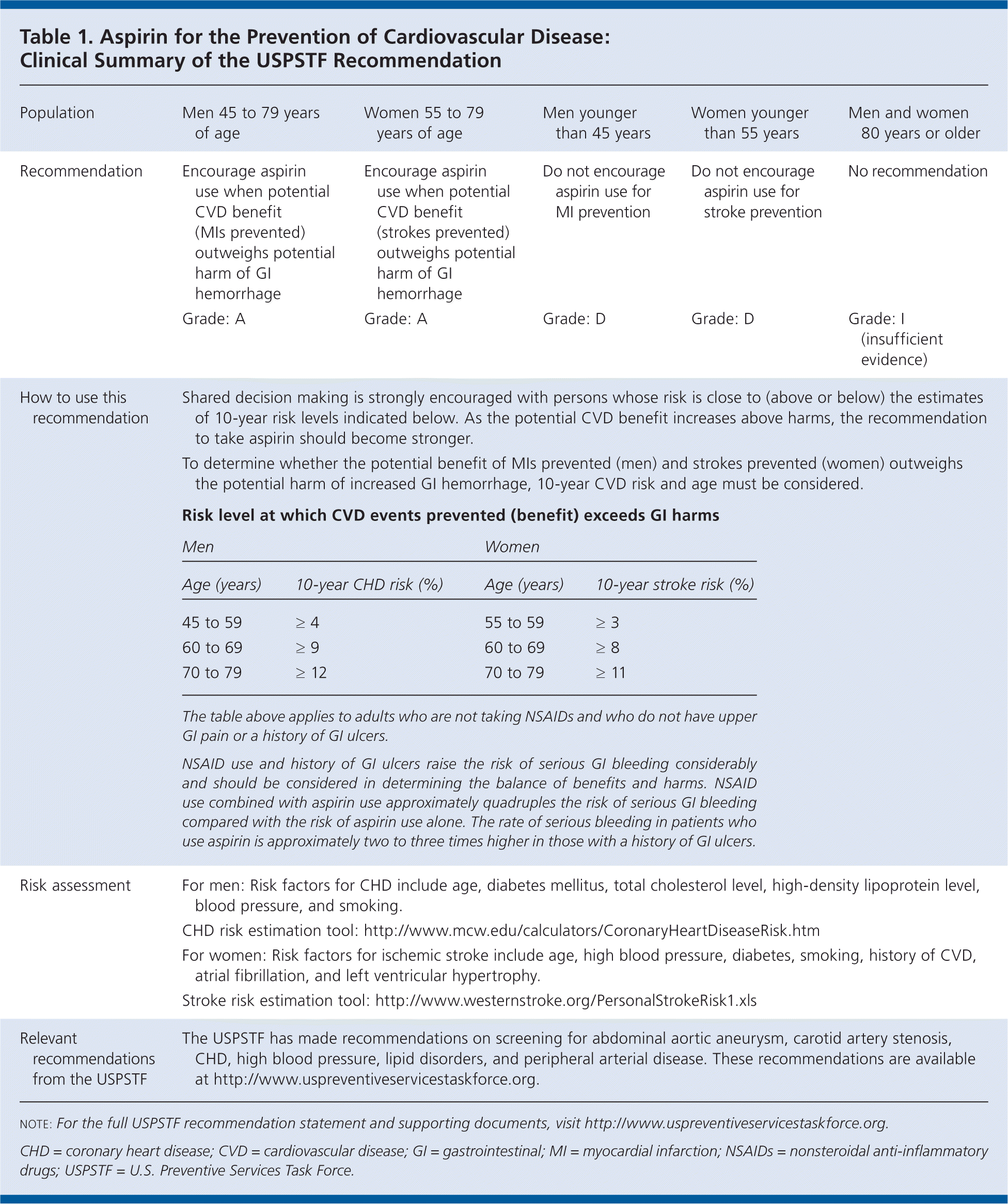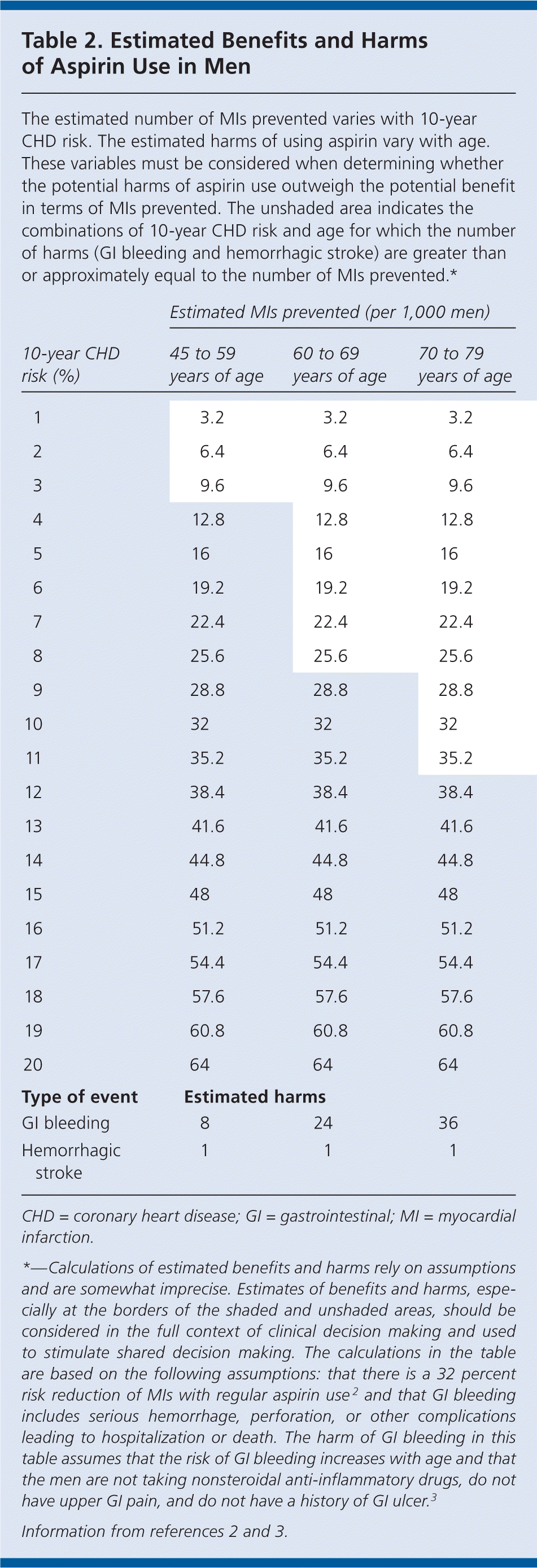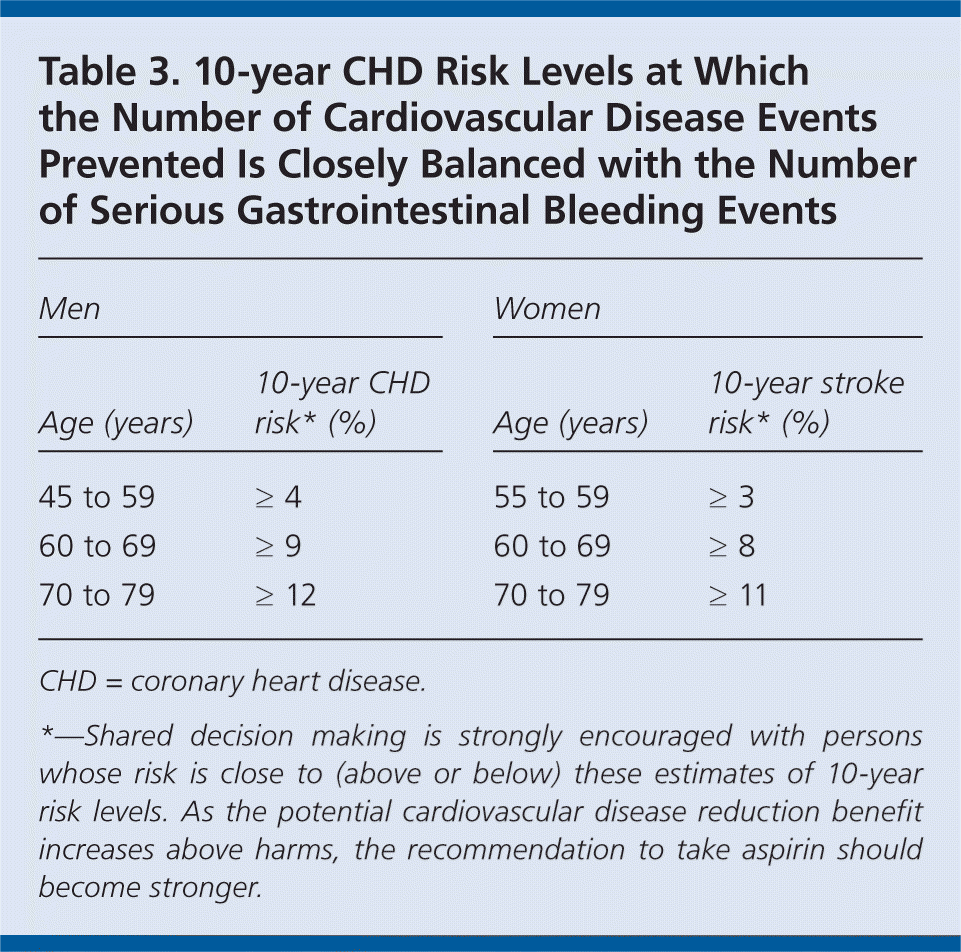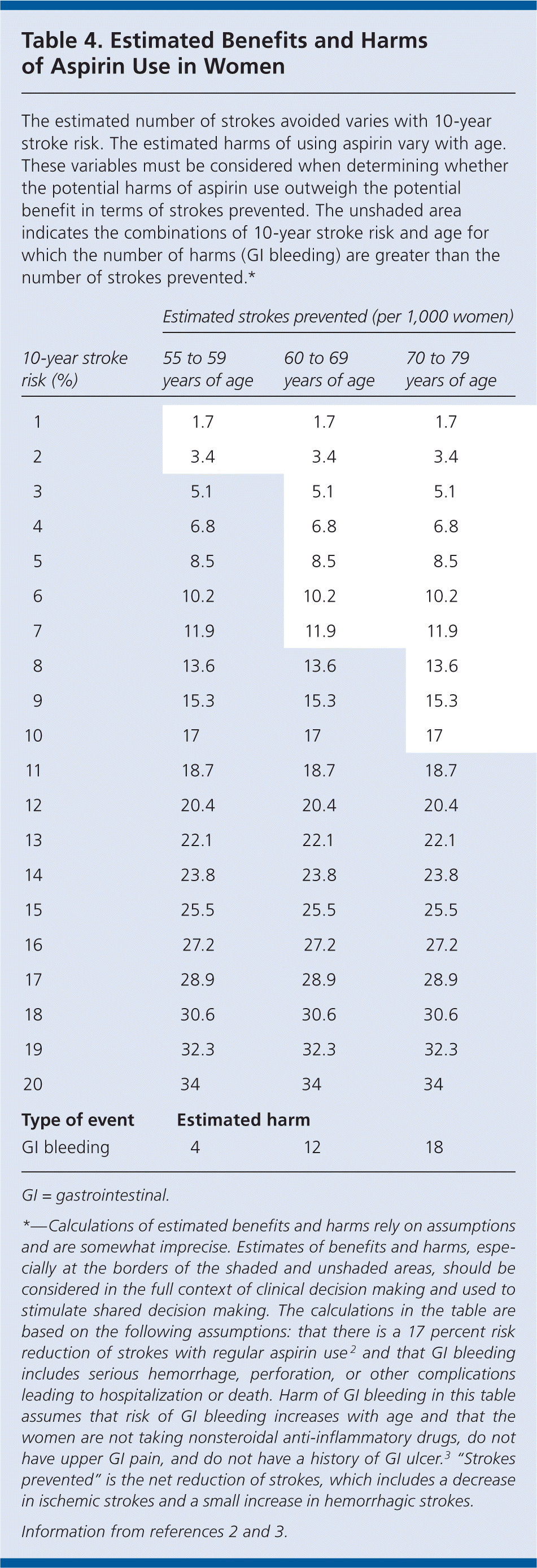
Am Fam Physician. 2011;83(12):1464-1468
Related Putting Prevention into Practice.
Related editorials: Appropriate Aspirin Use for Primary Prevention of Cardiovascular Disease and The Case Against Routine Aspirin Use for Primary Prevention in Low-Risk Adults
Summary of Recommendations and Evidence
The U.S. Preventive Services Task Force (USPSTF) recommends the use of aspirin in men 45 to 79 years of age when the potential benefit of a reduction in myocardial infarctions (MIs) outweighs the potential harm of an increase in gastrointestinal (GI) hemorrhage. A recommendation.
The USPSTF recommends the use of aspirin in women 55 to 79 years of age when the potential benefit of a reduction in ischemic strokes outweighs the potential harm of an increase in GI hemorrhage. A recommendation.
The USPSTF concludes that the current evidence is insufficient to assess the balance of benefits and harms of aspirin for cardiovascular disease (CVD) prevention in men and women 80 years and older. I statement.
The USPSTF recommends against the use of aspirin for stroke prevention in women younger than 55 years and for MI prevention in men younger than 45 years. D recommendation.
Rationale
Importance. CVD, including heart attack and stroke, is the leading cause of death in the United States.
Recognition of risk status. For many groups, risk calculators can provide an accurate estimate of the risk of coronary heart disease (CHD) events and strokes based on information about cardiovascular risk factors that include patient sex.
Benefits of preventive medication. The USPSTF found good evidence that aspirin decreases the incidence of MIs in men and ischemic strokes in women.
Harms of preventive medication. The USPSTF found good evidence that aspirin increases the incidence of GI bleeding and fair evidence that aspirin increases the incidence of hemorrhagic strokes.
USPSTF assessment. The USPSTF concludes that, in men 45 to 79 years of age whose benefit from a reduction in MIs exceeds the harm of an increase in GI bleeding, there is high certainty that the net benefit is substantial.
The USPSTF concludes that, in women 55 to 79 years of age whose benefit from a reduction in ischemic strokes exceeds the harm of an increase in GI bleeding, there is high certainty that the net benefit is substantial.
The USPSTF concludes that, in men and women 80 years and older, the evidence is insufficient to assess the balance of benefits and harms.
The USPSTF concludes that, in men younger than 45 years and women younger than 55 years, the potential benefits of reducing MIs in men or ischemic strokes in women are small, and there is moderate certainty that the benefits do not outweigh harms.
Clinical Considerations
PATIENT POPULATION
These recommendations apply to adult men and women with no history of CHD or stroke.
ASSESSMENT OF CVD RISK
Men
The net benefit of aspirin depends on the initial risk of CHD events and GI bleeding.1 Thus, decisions about aspirin therapy should consider the overall risks of CHD and GI bleeding.
Risk assessment for CHD should include ascertainment of risk factors: age, diabetes mellitus, total cholesterol levels, high-density lipoprotein cholesterol levels, blood pressure, and smoking. Available tools provide estimations of CHD risk (Table 1).

| Population | Men 45 to 79 years of age | Women 55 to 79 years of age | Men younger than 45 years | Women younger than 55 years | Men and women 80 years or older | |
| Recommendation | Encourage aspirin use when potential CVD benefit (MIs prevented) outweighs potential harm of GI hemorrhage | Encourage aspirin use when potential CVD benefit (strokes prevented) outweighs potential harm of GI hemorrhage | Do not encourage aspirin use for MI prevention | Do not encourage aspirin use for stroke prevention | No recommendation | |
| Grade: A | Grade: A | Grade: D | Grade: D | Grade: I (insufficient evidence) | ||
| How to use this recommendation | Shared decision making is strongly encouraged with persons whose risk is close to (above or below) the estimates of 10-year risk levels indicated below. As the potential CVD benefit increases above harms, the recommendation to take aspirin should become stronger. | |||||
| To determine whether the potential benefit of MIs prevented (men) and strokes prevented (women) outweighs the potential harm of increased GI hemorrhage, 10-year CVD risk and age must be considered. | ||||||
| Risk level at which CVD events prevented (benefit) exceeds GI harms | ||||||
| Men | Women | |||||
| Age (years) | 10-year CHD risk (%) | Age (years) | 10-year stroke risk (%) | |||
| 45 to 59 | ≥4 | 55 to 59 | ≥ 3 | |||
| 60 to 69 | ≥9 | 60 to 69 | ≥8 | |||
| 70 to 79 | ≥12 | 70 to 79 | ≥11 | |||
| The table above applies to adults who are not taking NSAIDs and who do not have upper GI pain or a history of GI ulcers. | ||||||
| NSAID use and history of GI ulcers raise the risk of serious GI bleeding considerably and should be considered in determining the balance of benefits and harms. NSAID use combined with aspirin use approximately quadruples the risk of serious GI bleeding compared with the risk of aspirin use alone. The rate of serious bleeding in patients who use aspirin is approximately two to three times higher in those with a history of GI ulcers. | ||||||
| Risk assessment | For men: Risk factors for CHD include age, diabetes mellitus, total cholesterol level, high-density lipoprotein level, blood pressure, and smoking. | |||||
| CHD risk estimation tool: http://www.mcw.edu/calculators/CoronaryHeartDiseaseRisk.htm | ||||||
| For women: Risk factors for ischemic stroke include age, high blood pressure, diabetes, smoking, history of CVD, atrial fibrillation, and left ventricular hypertrophy. | ||||||
| Stroke risk estimation tool: http://www.westernstroke.org/PersonalStrokeRisk1.xls | ||||||
| Relevant recommendations from the USPSTF | The USPSTF has made recommendations on screening for abdominal aortic aneurysm, carotid artery stenosis, CHD, high blood pressure, lipid disorders, and peripheral arterial disease. These recommendations are available at http://www.uspreventiveservicestaskforce.org. | |||||
Table 2 shows the estimated number of MIs prevented according to CHD risk level in men 45 to 79 years of age—the age range with the potential for substantial net benefit from the use of aspirin.2,3 It also shows that the CHD risk level at which the absolute number of MIs prevented by the use of aspirin is greater than the absolute number of GI bleeding episodes and hemorrhagic strokes caused by aspirin therapy increases with age. The estimates in Table 2 were developed assuming that the men are not currently taking nonsteroidal anti-inflammatory drugs (NSAIDs) and are without other conditions that increase the risk of GI bleeding.2,3 Furthermore, the decision about the exact level of risk at which the potential benefits outweigh potential harms is an individual one. Some men may decide that avoiding an MI is of great value, and that a GI bleeding event is not a major problem. These men would probably decide to take aspirin at a lower CHD risk level than men who are more concerned about GI bleeding. Men who have a high likelihood of benefit with little potential for harm should be encouraged to consider aspirin use. Conversely, aspirin use should be discouraged in men who have little potential of benefiting from the therapy or have a high risk of GI bleeding.

Shared decision making should be encouraged with men for whom the potential benefits of therapy and risks of serious bleeding are more closely balanced (Table 3). This discussion should explore the potential benefits and harms, and patient preferences. As the potential benefits begin to outweigh the potential harms, the recommendation to take aspirin should become stronger.

Evidence of the benefits in men younger than 45 years is limited, and the potential benefit in this age group is probably low because the risk of MI is very low.
Women
The net benefit of aspirin use depends on the initial risks of stroke and GI bleeding. Thus, decisions about aspirin therapy should consider the overall risks of stroke and GI bleeding.
Risk factors for stroke include age, high blood pressure, diabetes, smoking, a history of CVD, atrial fibrillation, and left ventricular hypertrophy. Tools for estimating stroke risk are available (Table 1).
Table 4 shows the estimated number of strokes prevented according to stroke risk level in women 55 to 79 years of age—the age range for which evidence shows that there could be substantial potential net benefit from aspirin use.2,3 It also shows that the stroke risk level at which the absolute number of strokes prevented is greater than the absolute number of GI bleeding events caused by aspirin use increases with age. The estimates in Table 4 were developed assuming that women are not currently taking NSAIDs and are without other conditions that increase the risk of GI bleeding.2,3 Furthermore, the decision about the exact stroke risk level at which the potential benefits outweigh harms is an individual one. Some women may decide that avoiding a stroke is of great value and that experiencing a GI bleeding event is not a major problem. These women would probably decide to take aspirin at a lower stroke risk level than those who are more concerned about GI bleeding. Women who have little potential of benefiting from aspirin therapy or have a high risk of GI bleeding should be discouraged from taking aspirin.

Shared decision making should be encouraged with women for whom the potential benefits and risks of serious bleeding are more closely balanced (Table 3). This discussion should explore potential benefits and harms and patient preferences. As the potential stroke reduction benefit increases above the potential harms, the recommendation to take aspirin should become stronger.
Evidence on benefits in women younger than 55 years is limited, and the potential benefit in this age group is probably low because the risk of stroke is very low.
ASSESSMENT OF GI BLEEDING RISK
Evidence shows that the risk of GI bleeding with and without aspirin use increases with age.3,4 For the purposes of making this recommendation, the USPSTF considered age and sex to be the most important risk factors for GI bleeding. Other risk factors for bleeding include upper GI tract pain, GI ulcers, and NSAID use. NSAID therapy combined with aspirin approximately quadruples the risk of serious GI bleeding compared with the risk of aspirin use alone. The rate of serious bleeding in persons who use aspirin is approximately two to three times greater in those with a history of a GI ulcer. Men have twice the risk of serious GI bleeding than women.3,4 These factors increase the risk of bleeding substantially and should be considered in the overall decision about the balance of benefits and harms of aspirin therapy. Enteric-coated or buffered preparations do not clearly reduce the adverse GI effects of aspirin. Uncontrolled hypertension and concomitant use of anticoagulants also increase the risk of serious bleeding.
TREATMENT
The optimal dose of aspirin for preventing CVD events is not known. Primary prevention trials have demonstrated benefits with various regimens, including dosages of 75 and 100 mg per day, and 100 and 325 mg every other day. A dosage of approximately 75 mg per day seems to be as effective as higher dosages. The risk of GI bleeding may increase with dose.
INTERVENTION INTERVALS
Although the optimal timing and frequency of discussions related to aspirin therapy are unknown, a reasonable option might be every five years in middle age and later, and also when other cardiovascular risk factors are detected.
SUGGESTIONS FOR PRACTICE REGARDING THE I STATEMENT
The incidence of MIs and strokes is high in persons 80 years and older, and thus the potential benefit of aspirin is large. The relationship between increasing age and GI bleeding is also well established and thus the potential harms are also large. The net benefit of aspirin use in persons 80 years and older is probably best in those without risk factors for GI bleeding (other than older age) and in those who could tolerate a GI bleeding episode (e.g., those with normal hemoglobin levels, good kidney function, or easy access to emergency care). Physicians should inform patients about the adverse consequences of GI bleeding because these events might be mitigated by early recognition of the signs and symptoms of bleeding (i.e., dark stools, vomiting blood, bright red blood per rectum, syncope, and lightheadedness). If physicians decide to prescribe aspirin in adults 80 years and older, they should do so only after a discussion with the patient that includes the potential harms and uncertain benefits.
